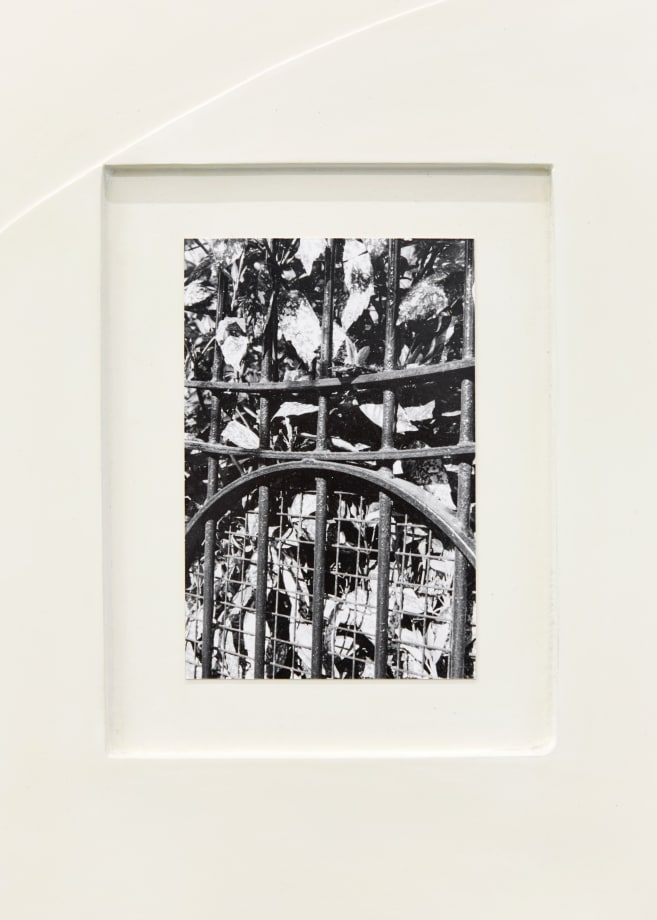In The Crystal World we are presented with an at times contradictory set of dualities: light and dark; order and disorder; the macro and microscopic; unification and differentiation. Works that on initial approach may present one way, quickly reveal a more prismatic nature, multifaceted and open to various readings. There is a visual clarity to the work of both artists; with their duo- chromatic palettes and almost geological geometry; they appear ordered, even systematic. However, on closer inspection it is apparent that both artists embrace and actively encourage natural imperfections and chance happenings; traces of the process and material history are visible. Mao’s sculptures hang from a single point, their own gravity giving structure to their forms so that they seem almost to hum with potential or vestigial motion. Brindley’s asymmetrical panels rupture the space around them, articulating and exploring it, emphasised by the pale grey wash painted behind them. Their crystalline formality is a counterpoint to the prosaic beauty caught by the photos held within, glimpsed moments of everyday disrepair and decline.
The title of one of Yeni Mao’s two sculptures - fig 23.4 cypher - alludes to hidden meanings within the work, a code or hidden message that may be unpacked by the viewer. The sculpture itself has an unselfconscious fluidity that is reminiscent of an individual's handwriting or doodled glyphs, somewhat reinforcing the idea that it is designed to be “read”. It has a feeling of an improvised or adapted tool with its leather thongs, wrapped rope and rusted and reclaimed iron, or perhaps a crude architectural measuring device such as Antonio Gaudi may have used to draw parabolas based upon gravitational forces. As we bring our focus in there are more stories to be uncovered; the rusted, flaking and paint-flecked surface of the iron carries the marks and traces of its history. We can see this gradually being over-written or over-run by a crystalline superstructure, a new saline frost bejewelling the decrepit surface below. Where these aspects meet - the rust and the rock, past and future, revealed and concealed - is the nexus of uncertainty that is foundational to Mao’s artworks.
Brindley, like Mao, also plays with this idea of visual and thematic layering and exploring the thresholds and interplay between form, function, ideology and idea. For the works in The Crystal World, he takes as his starting point two seemingly opposing artistic movements. For the Distances Collapsed considers the gap between Modernism and modernisation; the former being an ideology concerned with form and the latter being related to the concept of industry and economy of society. Through clarity, pattern and repetition, Modernism simplifies and codifies the world around us, and the history behind us. It is an aesthetic that lends itself to the digital and the synthetic; by its nature, it is rigid and static. It is therefore inevitably and repeatedly left behind by the onward march of modernisation, its sheen fading no sooner than it is formed. Blanks (a mad man's laughter) in turn, is inspired by the traditional Japanese aesthetic Wabi-sabi, which celebrates the imperfect, impermanent and the incomplete. In the simple form of Blanks (a mad man's laughter), its flowing lines accentuated by his use of the traditional shou sugi ban technique of scorching the wood to preserve it - Brindley has embraced the flaws of the elmwood and the marks of his chisel as intrinsic to the work, markers of its life and traces of its history. The photograph at its centre is a reminder of the inherent irony in trying to capture a transitional or transformative moment.
The artworks in The Crystal World are not only of their time, but they are also of time; they represent an accumulation of history, the perception and perspective of which is constantly shifting up to the point of conception, production and perhaps exhibition.
In J G Ballard’s 1966 novel The Crystal World, from which we borrow our title, he describes a temporal petrifaction, a crystalline necrosis that spreads through the landscape. In his words “...it’s as if a sequence of displaced but identical images of the same object were being produced by refraction through a prism, but with the element of time replacing the role of light”. Through a disruption in, and ultimately the halting of, time, a beautiful but terrible order is imposed upon nature; an echo of our own need to impose order upon the world around us.


